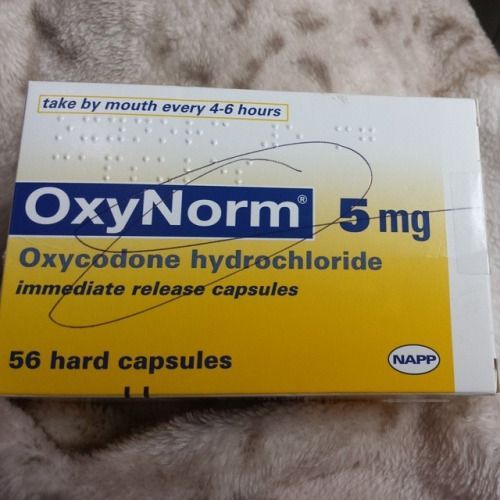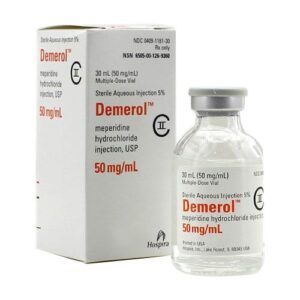Oxynorm 5mg should be taken at 4-6 hourly intervals. The dosage is dependent on the severity of the pain, and the patient’s previous history of analgesic requirements.
Increasing severity of pain will require an increased dosage of Oxynorm 5mg capsules. The correct dosage for any individual patient is that which controls the pain and is well tolerated throughout the dosing period. Patients should be titrated to pain relief unless unmanageable adverse drug reactions prevent this.
The usual starting dose for opioid naive patients or patients presenting with severe pain uncontrolled by weaker opioids is 5 mg, 4-6 hourly. The dose should then be carefully titrated, as frequently as once a day if necessary, to achieve pain relief. The majority of patients will not require a daily dose greater than 400 mg. However, a few patients may require higher doses.
Conversion from oral morphine:
Patients receiving oral morphine before oxycodone therapy should have their daily dose based on the following ratio: 10 mg of oral oxycodone is equivalent to 20 mg of oral morphine. It must be emphasised that this is a guide to the dose of Oxynorm 5mg capsules required. Inter-patient variability requires that each patient is carefully titrated to the appropriate dose.
Elderly patients:
A dose adjustment is not usually necessary in elderly patients.
Controlled pharmacokinetic studies in elderly patients (aged over 65 years) have shown that, compared with younger adults, the clearance of oxycodone is only slightly reduced. No untoward adverse drug reactions were seen based on age, therefore adult doses and dosage intervals are appropriate.
Patients with renal or hepatic impairment:
The plasma concentration in this patient population may be increased. The dose initiation should follow a conservative approach in these patients. The recommended adult starting dose should be reduced by 50% (for example a total daily dose of 10 mg orally in opioid naïve patients), and each patient should be titrated to adequate pain control according to their clinical situation.
Paediatric population:
Oxynorm 5mg capsules should not be used in patients under 18 years.
Use in non-malignant pain:
Opioids are not first-line therapy for chronic non-malignant pain, nor are they recommended as the only treatment. Types of chronic pain which have been shown to be alleviated by strong opioids include chronic osteoarthritic pain and intervertebral disc disease. The need for continued treatment in non-malignant pain should be assessed at regular intervals.
Method of administration
Oxynorm 5mg capsules are for oral use.
Duration of treatment
Oxycodone should not be used for longer than necessary. In common with other strong opioids, the need for continued treatment should be assessed at regular intervals.
Discontinuation of treatment
When a patient no longer requires therapy with oxycodone, it may be advisable to taper the dose gradually to prevent symptoms of withdrawal.
4.3 Contraindications
Hypersensitivity to oxycodone or to any of the excipients listed in section 6.1. Oxycodone must not be used in any situation where opioids are contraindicated: severe respiratory depression with hypoxia, paralytic ileus, acute abdomen, delayed gastric emptying, severe chronic obstructive lung disease, cor pulmonale, severe bronchial asthma, elevated carbon dioxide levels in the blood , moderate to severe hepatic impairment, chronic constipation.
4.4 Special warnings and precautions for use
The major risk of opioid excess is respiratory depression. Caution must be exercised when administering oxycodone to the debilitated elderly; opioid-dependent patients; patients with severely impaired pulmonary function, patients with impaired hepatic or renal function; patients with myxedema, hypothyroidism, Addison’s disease, toxic psychosis, prostate hypertrophy, adrenocortical insufficiency, alcoholism, delirium tremens, diseases of the biliary tract, pancreatitis, inflammatory bowel disorders, hypotension, hypovolaemia, raised increased intracranial pressure, head injury (due to risk of increased intracranial pressure) or patients taking MAO inhibitors.
Oxynorm 5mg capsules should not be used where there is a possibility of paralytic ileus occurring. Should paralytic ileus be suspected or occur during use, Oxynorm 5mg capsules should be discontinued immediately.
Oxynorm 5mg capsules should be used with caution pre-operatively and within the first 12-24 hours post-operatively.
As with all opioid preparations, oxycodone products should be used with caution following abdominal surgery as opioids are known to impair intestinal motility and should not be used until the physician is assured of normal bowel function.
Patients about to undergo additional pain relieving procedures (e.g. surgery, plexus blockade) should not receive Oxynorm 5mg capsules for 6 hours prior to the intervention.
with hypertensive or hypotensive crisis (see section 4.4).
Alcohol may enhance the pharmacodynamic effects of OxyNorm, concomitant use should be avoided.
Oxycodone is metabolised mainly by CYP3A4, with a contribution from CYP2D6. The activities of these metabolic pathways may be inhibited or induced by various co-administered drugs or dietary elements.
CYP3A4 inhibitors, such as macrolide antibiotics (e.g. clarithromycin, erythromycin and telithromycin), azole-antifungals (e.g. ketoconazole, voriconazole, itraconazole, and posaconazole), protease inhibitors (e.g. boceprevir, ritonavir, indinavir, nelfinavir and saquinavir), cimetidine and grapefruit juice may cause a reduced clearance of oxycodone that could cause an increase of the plasma concentrations of oxycodone. Therefore the oxycodone dose may need to be adjusted accordingly.
Some specific examples are provided below:
• Itraconazole, a potent CYP3A4 inhibitor, administered 200 mg orally for five days, increased the AUC of oral oxycodone. On average, the AUC was approximately 2.4 times higher (range 1.5 – 3.4).
• Voriconazole, a CYP3A4 inhibitor, administered 200 mg twice-daily for four days (400 mg given as first two doses), increased the AUC of oral oxycodone. On average, the AUC was approximately 3.6 times higher (range 2.7 – 5.6).
• Telithromycin, a CYP3A4 inhibitor, administered 800 mg orally for four days, increased the AUC of oral oxycodone. On average, the AUC was approximately 1.8 times higher (range 1.3 – 2.3).
• Grapefruit Juice, a CYP3A4 inhibitor, administered as 200 ml three times a day for five days, increased the AUC of oral oxycodone. On average, the AUC was approximately 1.7 times higher (range 1.1 – 2.1).
CYP3A4 inducers, such as rifampicin, carbamazepine, phenytoin and St John´s Wort may induce the metabolism of oxycodone and cause an increased clearance of oxycodone that could cause a reduction of the plasma concentrations of oxycodone. The oxycodone dose may need to be adjusted accordingly.
Some specific examples are provided below:
• St Johns Wort, a CYP3A4 inducer, administered as 300 mg three times a day for fifteen days, reduced the AUC of oral oxycodone. On average, the AUC was approximately 50% lower (range 37-57%).
• Rifampicin, a CYP3A4 inducer, administered as 600 mg once-daily for seven days, reduced the AUC of oral oxycodone. On average, the AUC was approximately 86% lower
Drugs that inhibit CYP2D6 activity, such as paroxetine and quinidine, may cause decreased clearance of oxycodone which could lead to an increase in oxycodone plasma concentrations. Concurrent administration of quinidine resulted in an increase in oxycodone Cmax by 11%, AUC by 13%, and t½ elim. by 14%. Also an increase in noroxycodone level was observed, (Cmax by 50%; AUC by 85%, and t½ elim. by 42%). The pharmacodynamic effects of oxycodone were not altered.
4.6 Fertility, pregnancy and lactation
Pregnancy
OxyNorm capsules are not recommended for use in pregnancy nor during labour.
There are limited data from the use of oxycodone in pregnant women. Infants born to mothers who have received opioids during the last 3 to 4 weeks before giving birth should be monitored for respiratory depression. Withdrawal symptoms may be observed in the newborn of mothers undergoing treatment with oxycodone.
Breastfeeding
Oxycodone may be secreted in breast milk and may cause respiratory depression in the newborn. OxyNorm capsules should, therefore, not be used in breast-feeding mothers.
4.7 Effects on ability to drive and use machines
Oxycodone may impair the ability to drive and use machines. Oxycodone may modify patients’ reactions to a varying extent depending on the dosage and individual susceptibility. Therefore, patients should not drive or operate machinery if affected.
This medicine can impair cognitive function and can affect a patient’s ability to drive safely. This class of medicine is in the list of drugs included in regulations under 5a of the Road Traffic Act 1988. When prescribing this medicine, patients should be told:
• The medicine is likely to affect your ability to drive.
• Do not drive until you know how the medicine affects you.
• It is an offence to drive while you have this medicine in your body over a specified limit unless you have a defence (called the ‘statutory defence’).
• This defence applies when:
o The medicine has been prescribed to treat a medical or dental problem; and
o You have taken it according to the instructions given by the prescriber and in the information provided with the medicine.
• Please note that it is still an offence to drive if you are












Reviews
There are no reviews yet.